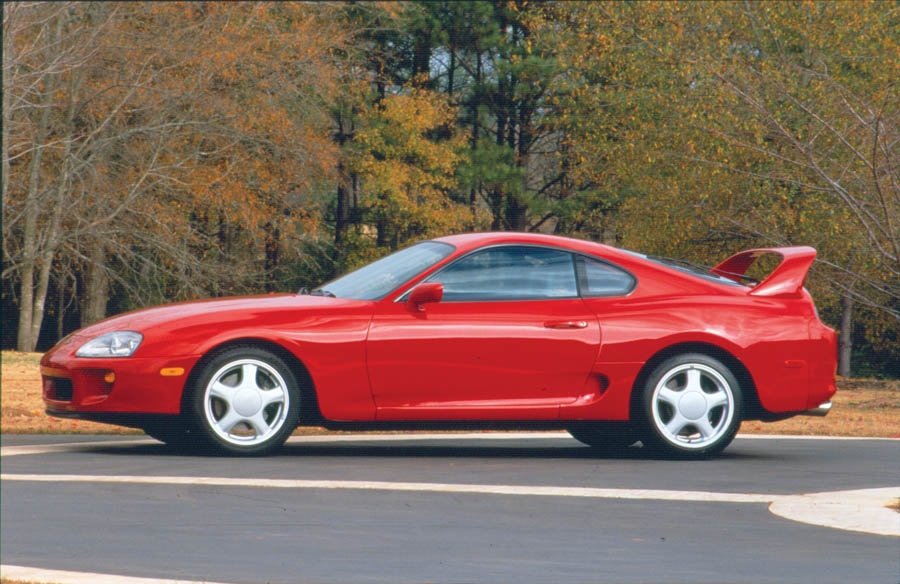
It’s hard to see Toyota as a performance brand, especially given the current state of their offerings, but for a time the staid Japanese megabrand produced some real hot rods.
The Toyota Supra started life as the performance model of the sporty Celica line. Designed to compete with the Nissan/Datsun Z-cars, the Supra was always given an overhead cam inline 6-cylinder engine. Horsepower ranged from an anemic 110 ponies in 1979 to a reasonably respectable 232 horses for the last of the Mark III Supra Turbos in 1993.
The final generation arrived in America in mid-1993 as the 1994 model year Supra Mk IV. With this car, Toyota finally showed that it was serious about performance, with 320 horsepower and 315 lb-ft of torque from a 3.0-liter DOHC twin-turbo engine and a Getrag/Toyota 6-speed manual transmission.
Out-of-the-box fun
The secret to all that power was Toyota’s sequential twin-turbo system. Designed to function like a twin-scroll turbo, the first of the two blowers was optimized to bring on the torque at just 1,800 rpm. The second turbo kicked in around 4,000 rpm to supply the boost for high-end horsepower. The new Supra did 0–60 mph in 4.6 seconds and covered the quarter-mile in 13.1 seconds — right off the showroom floor.
The Mk IV Supra Turbo was the most attractive design for Toyota since the unicorn-rare 2000GT of the 1960s. The new Supra featured flowing lines that contrasted sharply with its angular predecessors. Those good looks matched the look of the competition, including the Nissan 300ZX at 300 horsepower, the Mitsubishi 3000GT VR4 at 320 horsepower and the third-generation Mazda RX-7 at 255 horsepower.
In keeping with the day’s nascent tuner scene, the Supra Turbo also came with a big wing on the trunk — just in case you weren’t sure this was the fast one.
In the same years, there was also a normally aspirated version of the Supra that offered 220 horsepower and a 5-speed gearbox. Both the base Supra and the Turbo were also available with a rather ordinary 4-speed automatic transmission common to everything from the Cressida sedan to the Tacoma pickup — although why anyone would want one is a mystery. The automatic cut half a second off the 0–60 mph time.
Toyota sold 3,409 Supras in the United States in 1994 and 2,266 in 1995, but it’s not known how many were Turbos. Initial purchase price on the Supra Turbo was $42,800, while the base Supra came in at $35,800.
The OBD-ll hiccup
1996 is a watershed year for almost all cars, as it was the first year that OBD-II diagnostic and emissions technology was required on all U.S.-market passenger cars. To meet the higher OBD-II emissions standards, the slushbox was the only transmission Toyota put on the 1996 Supra Turbo. The combination of the automatic transmission and an eye-popping $48,700 ticket price was poisonous, and sales plummeted to just 852 cars.
Thankfully, Toyota brought back the 6-speed for 1997 and dropped the price back to $40,320. Sales recovered somewhat to 1,379 units for the 15th anniversary of the Supra nameplate. The final year of production in 1998 saw just 682 Supras sold, even though the price was lower than it had ever been at $39,198.
Not yet in the big time
Today, most Supra Turbos are still selling on Craigslist and eBay rather than land auctions, and most prices actually paid are in the $15,000–$30,000 range, with some peaking into $40k altitudes.
SCM’s Pocket Price Guide lists the Supra Turbo as ranging from $6,000 to $12,000, so we might be a little behind the times. Other price guides range a little higher, but not much.
A quick look at completed eBay auctions shows at least two unrequited sellers with big asking prices for every transaction that actually takes place — generally at a much lower price.
The other thing to notice is the extensive modification list on virtually every car for sale. The Supra’s starring role in “The Fast and the Furious” movie franchise did the available stock no favors, and you can be sure that each and every one of these modified cars has been badly abused.
The savvy buyer will hold out for a one-adult-owner car that has not been “improved.”
So what’s the bottom line? The Toyota Supra Mk IV Turbo is still an excellent performance car and represents the 1990s very well.
Financially, the breed shows little upside potential, but a car will likely hold value if you find a clean, unmolested example. A nice Mk IV Supra Turbo won’t get you into any concours, but it will be a hit at Cars and Coffee. ♦
